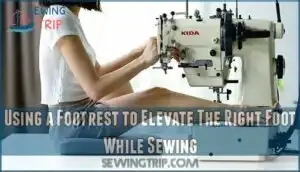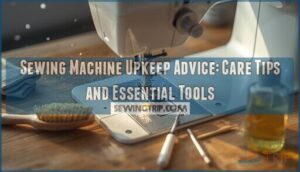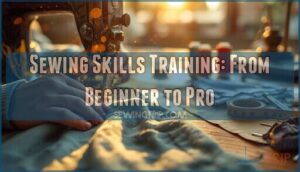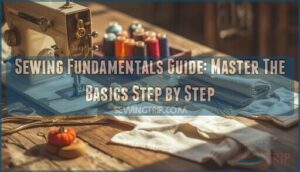This site is supported by our readers. We may earn a commission, at no cost to you, if you purchase through links.
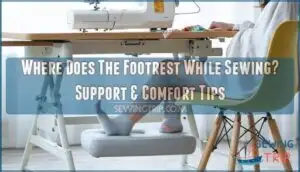
Position it directly in front of your sewing machine, aligned with your presser foot for ideal leg support. You can also place it slightly to your right side if you prefer elevating your right foot while operating the pedal with your left.
Some sewists find success positioning their footrest at an angle that matches their natural sitting posture. The key is finding a spot that keeps your legs comfortable and reduces strain during long stitching sessions.
Your knees should stay at roughly 90 degrees, with both feet supported. The perfect placement varies based on your height, chair, and sewing table setup—there’s more to optimizing your entire sewing ergonomics to ensure a healthy and efficient working environment, promoting long stitching sessions with minimal strain.
Table Of Contents
Key Takeaways
- Position your footrest directly in front of your sewing machine or slightly to the right for optimal pedal control and leg support during extended stitching sessions.
- Keep your knees at 90-degree angles with both feet supported to improve circulation, reduce strain, and maintain proper posture while sewing.
- Use creative alternatives like stacked books, pillows, storage bins, or cardboard boxes when you don’t have a dedicated footrest available.
- Adjust your footrest height to approximately 10% of your total height and periodically alternate foot positions to prevent muscle stiffness and maintain healthy blood flow.
Importance of Using a Footrest While Sewing
The magic of proper sewing ergonomics begins with your feet. You’ll dramatically reduce leg strain and improve posture by using a well-positioned footrest that maintains your knees and hips at comfortable 90-degree angles.
Your feet are the foundation of comfortable, strain-free sewing sessions.
This simple adjustment enhances circulation throughout your lower body while preventing the restless fidgeting that disrupts your stitching rhythm. A quality sewing footrest position keeps both feet stable and supported, allowing you to increase endurance during those marathon quilting sessions.
When you establish comfortable sewing posture through proper footrest placement sewing, your entire body thanks you. To further improve your posture, consider how to align your spine.
The right sewing machine footrest transforms tedious projects into enjoyable experiences, letting you focus on creating rather than managing discomfort.
Options for Footrest Placement While Sewing
When selecting your sewing footrest position, adjustable height options provide ideal positioning for different table setups.
Adjustable under-table footrests offer multiple height and tilt settings, accommodating various leg lengths while promoting comfortable sewing posture.
Sewing cabinets often include lockable rolling footrests positioned under the sewing surface, preventing slipping and guaranteeing machine compatibility.
For floor placement, you can position dedicated sewing footrests directly under your feet—even elevated by 2-4 inches—to resolve dangling leg issues when using taller chairs.
DIY footrests work too: stack books, use wooden blocks, or repurpose boxes placed under your desk for custom elevation.
Anti-fatigue mats positioned underfoot provide cushioning and reduce strain, serving as alternatives to traditional footrests.
Dedicated foot pedal risers position your sewing machine footrest at more comfortable heights, minimizing awkward leg extension.
These sewing ergonomics solutions guarantee your feet stay supported during long sessions.
A good footrest should also have adjustable height features for perfect customization.
Using a Footrest to Elevate The Right Foot While Sewing
Your right foot’s elevation during sewing sessions delivers substantial circulation improvement and posture correction benefits.
Placing a footrest under your dominant pedal foot reduces strain while maintaining that essential 90-degree knee angle.
The ergonomic benefits extend beyond comfort—proper foot support sewing setup prevents slouching and hip tension that plague marathon stitchers.
Footrests also help to promote natural body alignment.
For ideal footrest height, aim for approximately 10% of your total height.
A 5’11" sewist benefits from a 7-inch adjustable footrest positioned directly below the knee.
This sewing chair footrest arrangement enables smooth pedal control while promoting fatigue reduction throughout extended projects.
Memory foam or angled designs absorb vibration and prevent pedal shifting, creating a comfortable sewing posture that enhances accuracy.
The footrest benefits sewing enthusiasts experience include reduced varicose vein risk and improved blood return from calf muscles.
Remember to alternate your right foot position periodically—this simple movement prevents muscle stiffness and maintains healthy circulation during those satisfying, hours-long creative sessions.
Creative Alternatives for Footrests While Sewing
When proper sewing chair footrest options aren’t available, you’ll find countless makeshift footrest solutions around your home that provide excellent foot support sewing comfort.
These homemade footrest alternatives won’t cost you anything and can transform your sewing comfort tips experience immediately.
Here are four practical recycling options to create instant relief:
- Pillow Footrest: Place a firm pillow or folded blanket under your right foot for soft, moldable support that adjusts to your positioning needs.
- Stacked Books: Create an adjustable riser by stacking magazines or hardcover books to your preferred height – you can fine-tune the elevation easily.
- Storage Bin: Flip a plastic container upside down and use the lip edges as built-in foot rests for stable, wide support.
- Cardboard Boxes: Repurpose delivery boxes, cereal containers, or paper reams by placing them sideways and taping them closed for durability.
These creative solutions prove that effective foot support doesn’t require expensive equipment – just resourcefulness.
Consider how multi-functional furniture helps maximize space and comfort.
Frequently Asked Questions (FAQs)
How often should footrests be cleaned?
Clean your footrest weekly during regular use, or more often if you’re working on dusty projects. A quick wipe-down prevents buildup and keeps your workspace comfortable.
What materials work best for footrests?
While delicate fabrics demand gentle solutions, sturdy materials thrive with firm support.
You’ll find non-slip rubber provides excellent grip, while foam cushioning offers comfort during long sessions.
Wood creates stable platforms, and adjustable plastic components let you customize height perfectly for your needs.
Can footrests cause leg circulation problems?
Footrests actually prevent circulation problems when positioned correctly.
They improve blood flow by keeping your legs at proper angles and reducing pressure on your thighs, preventing swelling and numbness during extended sewing sessions, which is crucial for maintaining circulation.
Which footrest height suits different users?
Adjustable footrests work best since you’ll need different heights for sitting versus standing positions.
Set yours so your knees stay at ninety degrees – that’s your sweet spot for comfort and proper circulation.
Do footrests work with all machines?
Yes, footrests work with virtually all sewing machines since they’re separate ergonomic accessories that sit independently on your floor.
You’ll find compatible options for industrial, domestic, and specialty machines regardless of brand or model, making them a universal accessory for various sewing needs.
Conclusion
Sarah positioned her footrest right in front of her sewing machine but found her right leg cramping during a weekend quilting marathon.
After adjusting it slightly to the right, she could operate the pedal comfortably while keeping both feet supported.
Finding where does the footrest while sewing depends on your unique setup and comfort needs.
Whether you place it directly in front, angled to the side, or use creative alternatives like books or cushions, the goal remains consistent support for your legs.
Proper footrest positioning reduces strain, improves posture, and helps you enjoy longer sewing sessions without discomfort.
- https://www.quiltinghub.com/Articles/ArticleID/553
- https://www.thesewingdirectory.co.uk/how-to-use-a-buttonhole-foot/
- https://www.sewcanshe.com/blog/walking-foot-sewing-machine
- https://sacotin.com/en/rock-carry-on-or-weekender-bag-pattern/
- https://www.nytimes.com/wirecutter/reviews/best-under-desk-footrests/

